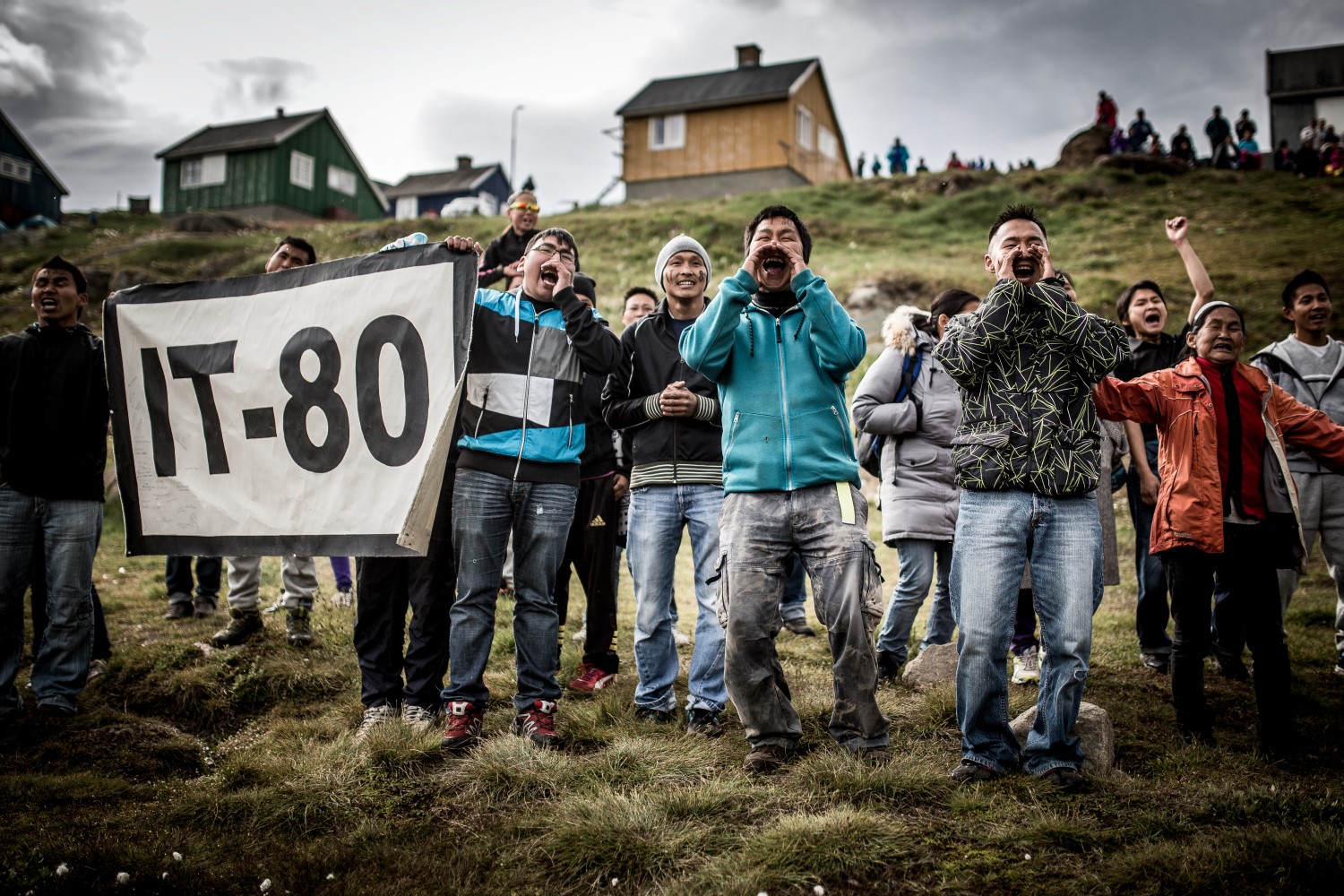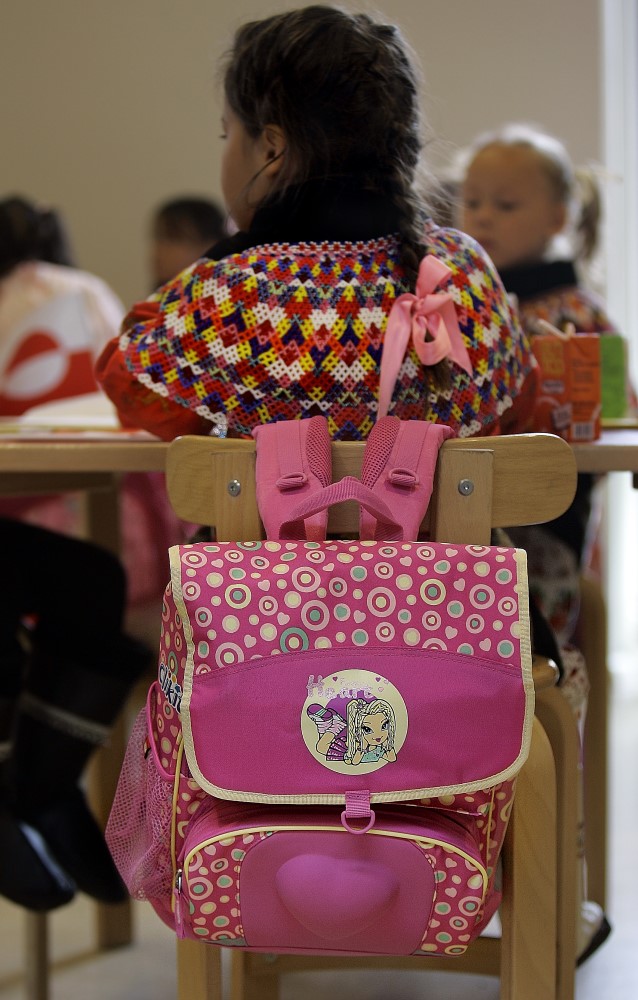
MADS PIHL/VISIT GREENLAND, 2013
The Greenlandic language is a branch of the Inuit languages spoken in a wide area of the Arctic: from west Inuit in Alaska and Inuit at the eastern tip of Siberia, as well as Inuit in Canada and Greenland. The area spans some 4,000 km and yet the entire area is surprisingly linguistically homogeneous, with many phonological and structural similarities. The number of Inuit speaking Inuit languages is less than 100,000, about half of whom speak Greenlandic.
Greenlandic is the official language of the country, and Danish can be used in public contexts. Public authorities and private companies with at least ten employees must develop a language policy.
The latest language policy act in Greenland was adopted on 19 May 2010. The aim is to provide a clear framework for the country’s language policy, including for linguistic integration. This must be done by ensuring that the Greenlandic language is complete and capable of supporting society as a whole, as well as by strengthening the language and its development as a native and second language. At the same time, the language policy must address and remove existing language barriers and promote language acquisition.
The Greenland Language Council is tasked with monitoring the development of the Greenlandic language, finding authoritative Greenlandic designations for imported words (replacements) and approving terminology.
The three main dialects

LISATHE MØLLER, 2021
The three main dialects, West Greenlandic, North Greenlandic and East Greenlandic, are quite distinct. Towns and settlements each have their local dialect, and if you hear a Greenlander speak, you can often tell which town or settlement they come from.
There is no legislation governing the oral language, everyone can use their own dialect, but in writing people are required to use standard writing and must follow the orthographic rules. Yet, more Greenlanders often write in their own dialect; for example, East Greenlanders and North Greenlanders often write dialect on social media.
Language use until the mid-1900s
From Hans Egede’s arrival in 1721 until World War II almost all inhabitants spoke Greenlandic, including the missionaries. The missionaries managed to translate the religious language into Greenlandic, and the first dictionary, published by Hans Egede’s son Poul Egede, came out already in 1750.
In the catechist seminaries in Godthåb (Nuuk) and Jakobshavn (Ilulissat), established in 1847 and 1848, respectively, teaching was conducted in Greenlandic. Danish was one among several subjects, and in the 1860s, Danish was taught five hours a week.
In 1851, seminary teacher Samuel Kleinschmidt published a Greenlandic grammar which described the language on the basis of morphology. At the same time, he developed the first actual orthography, which until 1973 was used as standard orthography. The transition from the old to the new orthography took place gradually, and there are still reminiscences of the old orthography, which can be used, for example, in the Greenlandic personal names. The new orthography is phonemically oriented, meaning that the spoken and written language have come closer each other.
From the early 1900s up to the 1950s, many authors wrote in Greenlandic, and the first novel in Greenlandic, Sinnattugaq, written by rural dean Mathias Storch, came out in 1914.
The use of language from 1950 to the 1970s
From around 1950, a vigorous Danisation of Greenlandic society occurred. Since there was a lack of trained Greenlandic teachers and Greenlandic teaching books, it was necessary to understand Danish in order to pursue further education. A new school act in 1967 introduced an option to postpone Greenlandic teaching until the third year of school, so as to give children better opportunities to learn Danish.
During the 1960s, the school structure approached that of Denmark. After the 6th grade, Greenlandic children were commonly sent to Denmark for one year to improve their language skills. Many who grew up at that time spoke Danish without any problems, but for a large part, this resulted in inferior skills in written Greenlandic.
The use of language from the 1970s up to the present day
The introduction of Home Rule in Greenland brought significant changes to the language policy. The Greenland Home Rule Act states that the Greenlandic language is the main language and that at the same time the Danish language must be thoroughly taught. It must be possible to use Greenlandic and Danish in all public contexts. The strengthening of the Greenlandic language was ensured in the school law of 1979, in which Greenlandic became the language of instruction from the 1st grade and Danish became the first foreign language. From that day, it was compulsory to teach Danish as a foreign language from the 4th grade and English from the 7th grade.
The priority of Greenland teaching has improved the mother tongue skills of those speaking the Greenlandic language. A language study from 1999 found that 69.1 % of the population spoke Greenlandic, 15 % were bilingual (Greenlandic and Danish), while about 15 % only spoke Danish. A study from 2003 of the language of 14 to 17-year-olds found that 94.6 % of young people could speak Greenlandic, while 73.3 % could also speak Danish.
In the two language studies, the respondents had stated their language skills themselves. If you look at them objectively, the figures may turn out to be different, but nevertheless, it is evident that more and more Greenlanders speak both Greenlandic and Danish.
The only both quantitative and qualitative language study was conducted in Qaqortoq in 2001. The study participants included people born in 1959, who had grown up in a time of great focus on the Danish language, and young people born in 1982 and 1983 who had grown up under the Home Rule during the Greenlandisation. The results showed that those who grew up during the Danisation were bilingual, but that many of them are not very good at writing Greenlandic. The young people who grew up during the Greenlandisation speak mainly Greenlandic, and many of them do not speak Danish very well.

DEN ARKTISKE LEVEVILKÅRSUNDERSØGELSE/SLICA, 2007
The language and the education problem

FINN FRANDSEN/POLITIKEN/RITZAU SCANPIX, 2007
For some, the increasing number of monolingual young Greenlanders has meant inferior educational opportunities, because although teaching in primary schools is primarily in Greenlandic, higher education is primarily conducted in Danish.
The language of instruction in upper secondary schools is Danish, except in the subject Greenlandic, and almost all higher education requires Danish skills. There are several reasons for this: There is a lack of Greenlandic teachers, the vast majority of teaching books are in Danish, and in many disciplines no specific Greenlandic terminology has been developed.
Only two higher educational programmes do not require Danish skills: the carpentry training programme and the decentralised social worker training programme. Both training programmes are aimed at adults with practical experience.
The degree programmes at the Ilisimatusarfik University are primarily conducted in Danish. However, if the teacher speaks Greenlandic, teaching can be conducted in Greenlandic.
The language of administration
Although the language policy act from 2010 state that the Greenlandic language is used in public contexts, much of the language of administration is still Danish.
The Inatsisartut (Parliament) rules of procedure stipulate that negotiations should be conducted in Greenlandic, but that members of Inatsisartut and Naalakkersuisut (government), who do not speak Greenlandic, may speak Danish with interpretation into Greenlandic, and that it must be possible to follow negotiations in Danish. All documents relating to Inatsisartut and Naalakkersuisut are translated to be available in both Greenlandic and Danish. Therefore, there are many translators and interpreters in the Government of Greenland, and well-educated Greenlanders are assigned interpreting tasks along with their normal job.
With this amount of translations, translators and interpreters are significant language developers. Unfortunately, they are not always familiar with the specific terminology in individual fields, and this may lead to imprecise translations that cause confusion. The Language Council and the Language Secretariat investigate and develop the Greenlandic language, including in relation to terminology.
Further reading
- Education
- Home Rule (1979‑2008)
- Literature
- Plans in Greenland
- Population and demographics
- Self-Government
- The media in Greenland
- Towns and settlements
Read more about Culture in Greenland
